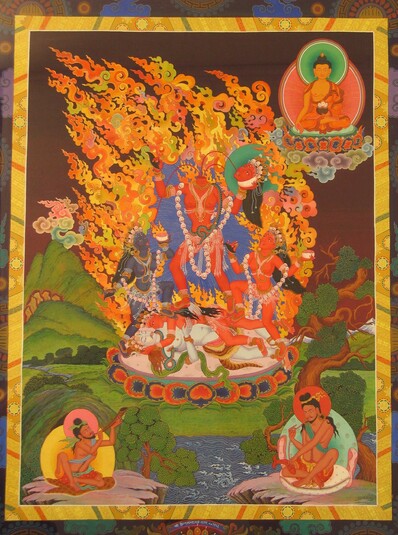
Item: Vajrayogini (Buddhist Deity) - Chinnamasta (Severed-head)
| Origin Location | Nepal |
|---|---|
| Date Range | 1960 - |
| Material | Ground Mineral Pigment on Cotton |
| Collection | Rubin Museum of Art |
Classification: Deity
Appearance: Semi-Peaceful
Gender: Female
Chinnamasta Vajrayogini, the Severed-headed Goddess. Artist: Dinesh and Uday Charan Shrestha, Nepal, 1992.
With three streams of blood pulsing from the open neck of the upright animate torso, feeding the mouth of the severed head along with the mouths of the two attendant figures at the right and left, this Goddess is surely the most dramatic and unusual in the joint pantheons of the Buddhists and Hindus. A shared goddess with Buddhist origins, this deity is packed with layers of symbolism and coded mnemonic information that hints at the macrocosm and microcosm of the universe manifest in the human body - a basic paradigm of Tantra methodology.
The Severed-headed Goddess is no longer common in either of the great religions. She continues on in art and obscure religious texts despite any strong living tradition of practice or a dedicated temple for worship. However, this is a modern painting maintaining a traditional composition and textually accurate depictions of all the figures portrayed. The colors, decorative elements and landscape have all been updated to a new and modern Nepalese aesthetic creating a sacred artwork for a modern practitioner of the cult of the Severed-headed Goddess.
Jeff Watt 5-2005
Exhibition: Female Buddhas at RMA
Thematic Sets
Buddhist Deity: Vajrayogini (Miscellaneous Forms)
Buddhist Deity: Vajrayogini, Chinnamasta (Severed-head)
Contemporary Art: Nepalese Traditional (Misc.)
Exhibition: Artist-in-Residence Showcase
Collection of Rubin Museum of Art (RMA): Main Page
Collection of Rubin Museum of Art: Nepal
